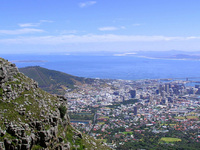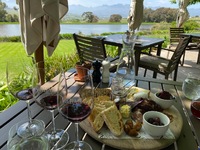Cape Town is ideal as a nice, warm get away during the North Hemisphere’s cold winter months. In South Africa, the time between January and March are the best days of summer.
For a summer resort to be nice for me, the moisture level should be near zero and Cape Town, with its warm, dry, and breezy weather, fulfills my expectations. Since Cape Town has a rather warm climate, its white wines are more successful than others. There are more than a hundred wineries that can be visited within an hour or two away from Cape Town. Firstly, I would like to talk about the ones I liked among the wineries I saw. There are many places in the Stellenbosh area that serve as both hotels and restaurants. It’s possible to tour the entire region in two days. If you want to stay for a few nights, very nice hotels are also available
KEN FORRESTER
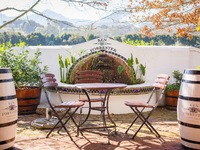 Ken Forrester is located in an area around 45 minutes from Cape Town. This place has been awarded by WWF for being one of the most organic and environmentally friendly wineries in the world. Ken Forrester himself is always there. He even greets customers from time to time. Everyone working is very knowledgeable about wine and grapes. The history of the place dates way back. In the 1700s, it used to be a winery called Zandberg. It changed hands in the 1800s and was bought by the Forrester family in 1993. A winemaker himself, Ken Forrester, changed the grape profile in the area and planted new grape seeds. He eventually concentrated on Chenin Blanc, a white wine grape that is very suitable to South Africa and rarely found anywhere else. Although Forrester planted many other grapes in its vineyards, most of the product consists of Chenin Blanc. I’ve tried many wines in South Africa, and red wines aren’t very notable, but white wines are really good.
Ken Forrester is located in an area around 45 minutes from Cape Town. This place has been awarded by WWF for being one of the most organic and environmentally friendly wineries in the world. Ken Forrester himself is always there. He even greets customers from time to time. Everyone working is very knowledgeable about wine and grapes. The history of the place dates way back. In the 1700s, it used to be a winery called Zandberg. It changed hands in the 1800s and was bought by the Forrester family in 1993. A winemaker himself, Ken Forrester, changed the grape profile in the area and planted new grape seeds. He eventually concentrated on Chenin Blanc, a white wine grape that is very suitable to South Africa and rarely found anywhere else. Although Forrester planted many other grapes in its vineyards, most of the product consists of Chenin Blanc. I’ve tried many wines in South Africa, and red wines aren’t very notable, but white wines are really good.
Ken Forrester is considered as one of the best brands in the world when it comes to Chenin Blanc. Like Babylonstoren, pesticides and fertilizers aren’t used here; everything’s organic. However, they add sulfur as a preserver to some of their wines. The higher the quality and hygiene of the wine, the less sulfur has to be put in. But if 100 thousand bottles of wine are produced in a factory, it’s not very possible to check the hygiene of each bottle. As a result, they usually add sulfur quite generously to prevent it from spoiling. This is also the reason behind the terrible headaches some of the wines cause. If several thousand bottles of wine are produced, though, it’s more possible to pay attention to hygiene, and therefore less sulfur can be added. In Ken Forrester, the amount of sulfur used is very reasonable. Other than the wine, they have some really nice cheese they purchase from a cheese farm. It’s possible to feel full with cheese plates served during wine testing.
One of the interesting facts about this place is that they make a type of wine that is not very common in other parts of the world. Wines are usually made from grapes of the same year. However, Ken Forrester mixes grapes from three different years while making its Chenin Blanc. That’s why there is no year written on the bottles. There’s also no sulfur in these wines. This method is also used in the making of some champagnes. Drink these wines as soon as you can and take good care of them to prevent them from deteriorating. The champagnes Ken Forrester makes with this method live 10 years.
JORDAN ESTATE
Jordan Estate, the winery with the largest variety of wines in the region, was established 300 years ago. It was bought by its current owners, Gary and Kathy Jordan, in 1982. The couple worked in Napa Valley, California, for two years and transferred their know-how to the Jordan Estate. It’s a beautiful place with the buildings around, its winery, cafe, wine shop, and tasting menu. They brought systems suitable for the Bourgogne method in production. They’re using a different technique for red wines, and they have industrialized this technique.
There’s a small hotel, two restaurants, and a bakery within Jordan Estate. Kathy Jordan established a foundation in 2012 and started to provide funds and opportunities to women who want to take part in wine production around the world. This ambition is reflected in their business as there are many women working in the estate. Approximately 700 thousand bottles are produced here annually, half of which is white and the other half are red. They use every kind of grape that grows on the soil here. Jordan Estate is very pleasurable to visit and drink good wine. You can see the wines from here in many places around the world, including Turkey.
DeMORGENZON
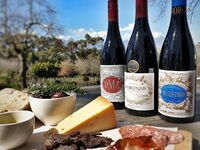 Even if the wines aren’t incredibly good, Demogezon is a really nice winery with beautiful architecture. Their production per year reaches several thousand bottles. The owner’s residence is located on the southern slope of a hill about 400 meters above the vineyards. The winery is located at the bottom of the hill. The interesting thing is that there are speakers playing classical music all over that huge vineyard. The same sound system is also in the winery and the tasting area.
Even if the wines aren’t incredibly good, Demogezon is a really nice winery with beautiful architecture. Their production per year reaches several thousand bottles. The owner’s residence is located on the southern slope of a hill about 400 meters above the vineyards. The winery is located at the bottom of the hill. The interesting thing is that there are speakers playing classical music all over that huge vineyard. The same sound system is also in the winery and the tasting area.
The owner of Demogezon created this unusual system thinking that some classical music pieces have a good effect on the grapes and increase their quality. He even has a playlist that visitors can buy as a CD. Service quality is good, and the wine-tasting ritual is great. The view and music are incredible, and the wine is okay. But overall, Demogezon is a great experience.
It is very enjoyable to walk among the vineyards while listening to classical music. I’m not sure if music has any positive impact on the grapes, but it certainly had an impact on me.
GLENELLY
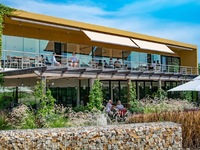 I think this is the most important place to go among all the wineries. Glenelly is a well-established place that was founded in 1682. It was bought in 2003 by May-Eliane de Lencquesaing, owner of the very famous Pauillac winery Château Pichon Longueville Comtesse de Lalande. She was 78 when she left her castle, vineyard, and winery in France and moved to Cape Town for Glenelly. De Lencquesaing also brought her winemaker along with her to apply the French winemaking techniques here. Her main focus has been Glenelly for the past 20 years. Wine is pumped somewhere as it is produced. This procedure creates a mechanical effect that has a negative impact on the wine. For the last 50 years, vertical systems have been installed across the world, which allows the gravitational force to do all the work rather than relying on horizontal systems. In these vertical systems, wine automatically flows to the lower floor when the process is completed. And when the process on the lower floor is done, it moves one floor more with the help of gravity. May–Elaine de Lencquesaing is the one who brought this technique to South Africa from France. There are very few wineries in South Africa that make very good red wine, and Glenelly is one of them. Reds make up the majority of Glenelly’s wine production. I recommend visiting Glenelly to taste their red wines. They serve French dishes as well as local cuisine in their restaurant. When I learned that May-Elaine de Lencquesaing has the largest glass collection in Europe and that she brought some of the pieces to South Africa and, on top of it all, opened a glass museum in Glenelly, I wanted to visit this museum on site too. The museum isn’t a large space; it’s the size of a restaurant. An experienced lady is the curator of the museum, and she leads the tour that lasts 1.5 hours. Showcasing glass objects from various periods and cultures, the oldest of which is dated before the common era, the museum is truly beautiful. It’s impossible to leave the museum unimpressed as the curator lady so elaborately tells the history of glass.
I think this is the most important place to go among all the wineries. Glenelly is a well-established place that was founded in 1682. It was bought in 2003 by May-Eliane de Lencquesaing, owner of the very famous Pauillac winery Château Pichon Longueville Comtesse de Lalande. She was 78 when she left her castle, vineyard, and winery in France and moved to Cape Town for Glenelly. De Lencquesaing also brought her winemaker along with her to apply the French winemaking techniques here. Her main focus has been Glenelly for the past 20 years. Wine is pumped somewhere as it is produced. This procedure creates a mechanical effect that has a negative impact on the wine. For the last 50 years, vertical systems have been installed across the world, which allows the gravitational force to do all the work rather than relying on horizontal systems. In these vertical systems, wine automatically flows to the lower floor when the process is completed. And when the process on the lower floor is done, it moves one floor more with the help of gravity. May–Elaine de Lencquesaing is the one who brought this technique to South Africa from France. There are very few wineries in South Africa that make very good red wine, and Glenelly is one of them. Reds make up the majority of Glenelly’s wine production. I recommend visiting Glenelly to taste their red wines. They serve French dishes as well as local cuisine in their restaurant. When I learned that May-Elaine de Lencquesaing has the largest glass collection in Europe and that she brought some of the pieces to South Africa and, on top of it all, opened a glass museum in Glenelly, I wanted to visit this museum on site too. The museum isn’t a large space; it’s the size of a restaurant. An experienced lady is the curator of the museum, and she leads the tour that lasts 1.5 hours. Showcasing glass objects from various periods and cultures, the oldest of which is dated before the common era, the museum is truly beautiful. It’s impossible to leave the museum unimpressed as the curator lady so elaborately tells the history of glass.
GRAFF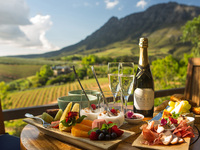 Graff is a very famous winery and hotel owned by a famous diamond merchant from the Netherlands. Wines are in line with South African standards, but the restaurant and hotel are something else. It’s a boutique hotel with 10 rooms - but don’t be fooled by the number and think it’s a small space; each room is a 200 m2 suite, and each suite has its own 200 m2 garden. It gets better; each garden includes an exclusive swimming pool for the people staying in the room. These gardens are surrounded by tall trees and create privacy. Five of the rooms overlook a cliff with a view of vineyards. When the sliding doors of the rooms open, the spacious room becomes one with the garden and takes the visitor’s breath away. Even so, you can jump into your exclusive pool by taking two steps from your bed. Everything here is designed thoughtfully with the guests’ comfort and pleasure in mind. A little while after you settle into your room, an attendant with a huge tray knocks on your door. He brings treats like a fruit platter and champagne in an ice bucket and asks when he can come back with more treats. The next time he visits, he brings white wine to the ice bucket along with canapes. Graff also has an incredible restaurant, but you need to make reservations well in advance. It serves international cuisine with an a la carte menu. It’s a beautiful place with a view of vineyards stretching for kilometers. The wine list consists of wines that they produce themselves. The most attractive part of Grass is the luxurious personal service and atmosphere.
Graff is a very famous winery and hotel owned by a famous diamond merchant from the Netherlands. Wines are in line with South African standards, but the restaurant and hotel are something else. It’s a boutique hotel with 10 rooms - but don’t be fooled by the number and think it’s a small space; each room is a 200 m2 suite, and each suite has its own 200 m2 garden. It gets better; each garden includes an exclusive swimming pool for the people staying in the room. These gardens are surrounded by tall trees and create privacy. Five of the rooms overlook a cliff with a view of vineyards. When the sliding doors of the rooms open, the spacious room becomes one with the garden and takes the visitor’s breath away. Even so, you can jump into your exclusive pool by taking two steps from your bed. Everything here is designed thoughtfully with the guests’ comfort and pleasure in mind. A little while after you settle into your room, an attendant with a huge tray knocks on your door. He brings treats like a fruit platter and champagne in an ice bucket and asks when he can come back with more treats. The next time he visits, he brings white wine to the ice bucket along with canapes. Graff also has an incredible restaurant, but you need to make reservations well in advance. It serves international cuisine with an a la carte menu. It’s a beautiful place with a view of vineyards stretching for kilometers. The wine list consists of wines that they produce themselves. The most attractive part of Grass is the luxurious personal service and atmosphere.
BABYLONSTOREN Babylonstoren is a farm of about 100 acres, almost all of which are farmed. They grow vegetables and grapes, all organically. No pesticides and fertilizers are used. Thus, there are no preservers like sulfur in their wines. They organically raise animals too. The only thing that they don’t raise is fish; they buy it. In a restaurant for 20-30 people, where it is very difficult to find a place, they serve meals consisting of products grown on the farm. The last time I visited Cape Town, I made reservations a month prior and had the chance to eat at Babylonstoren. However, this time around, I couldn’t go as they were full. They only sell the organic wine they make on the farm. Babylonstoren is an interesting place with all its organic produce. Wines are light, not spectacular, but good. Organic wine is different. Some get better as it ages, while some deteriorate. You never know. So if you ever get your hands on organic wine, try to consume it early. The place also has a 20-room hotel made up of wooden houses in a garden, resembling a campground. These studio-type houses are 100 m2, but are designed in an extremely simple way. The “All organic” principle is also adopted in the pool as well which I find very interesting. No preservers are used in the water, it’s all covered with seaweed, but people still enjoy swimming in it. Food is incredible at Babylonstoren, so overall it offers a very good experience to people visiting the region. Wineries that are built in the middle of vineyards, like Babylonstoren are the best because grapes need to be processed quickly without being damaged. To avoid any incidents, the distance between the grape collected and the winery should be very short. Otherwise, the grape loses its potency. That’s where “wine making begins from the soil” comes from.
Babylonstoren is a farm of about 100 acres, almost all of which are farmed. They grow vegetables and grapes, all organically. No pesticides and fertilizers are used. Thus, there are no preservers like sulfur in their wines. They organically raise animals too. The only thing that they don’t raise is fish; they buy it. In a restaurant for 20-30 people, where it is very difficult to find a place, they serve meals consisting of products grown on the farm. The last time I visited Cape Town, I made reservations a month prior and had the chance to eat at Babylonstoren. However, this time around, I couldn’t go as they were full. They only sell the organic wine they make on the farm. Babylonstoren is an interesting place with all its organic produce. Wines are light, not spectacular, but good. Organic wine is different. Some get better as it ages, while some deteriorate. You never know. So if you ever get your hands on organic wine, try to consume it early. The place also has a 20-room hotel made up of wooden houses in a garden, resembling a campground. These studio-type houses are 100 m2, but are designed in an extremely simple way. The “All organic” principle is also adopted in the pool as well which I find very interesting. No preservers are used in the water, it’s all covered with seaweed, but people still enjoy swimming in it. Food is incredible at Babylonstoren, so overall it offers a very good experience to people visiting the region. Wineries that are built in the middle of vineyards, like Babylonstoren are the best because grapes need to be processed quickly without being damaged. To avoid any incidents, the distance between the grape collected and the winery should be very short. Otherwise, the grape loses its potency. That’s where “wine making begins from the soil” comes from.
HARBOUR HOUSE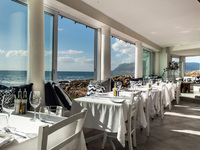 Harbour House looks very much like many fish restaurants by the sea. There are several huge blackboards on which they have written the meals of the day and their prices. Two waiters carry one of the blackboards to your table and help you order. But the best part is, the waiter will definitely tell you which of the fish is fresh, which is frozen. Fish is bought fresh every day in Harbour House, but the fish that weren’t served that day are frozen to save for the following days. This information is not written on the blackboard, but they definitely do tell you. They even have their own name for the frozen fish, “freshly frozen.” Fish are delicious as they’re caught in the open sea. Crayfish, insects, lobster, and shrimp are in abundance and thus on the menu. They serve plenty of salad, which makes it an ideal restaurant for me. You can try everything at Harbour House, particularly grilled fish. You can also find a wine menu with South African wines. Harbour House is located in a very popular area called Waterfront, but they also have a branch in Kalk Bay which you can visit if you have time. Kalk Bay is 45 minutes away from the city and is located in an area right after you pass the Cape of Good Hope.
Harbour House looks very much like many fish restaurants by the sea. There are several huge blackboards on which they have written the meals of the day and their prices. Two waiters carry one of the blackboards to your table and help you order. But the best part is, the waiter will definitely tell you which of the fish is fresh, which is frozen. Fish is bought fresh every day in Harbour House, but the fish that weren’t served that day are frozen to save for the following days. This information is not written on the blackboard, but they definitely do tell you. They even have their own name for the frozen fish, “freshly frozen.” Fish are delicious as they’re caught in the open sea. Crayfish, insects, lobster, and shrimp are in abundance and thus on the menu. They serve plenty of salad, which makes it an ideal restaurant for me. You can try everything at Harbour House, particularly grilled fish. You can also find a wine menu with South African wines. Harbour House is located in a very popular area called Waterfront, but they also have a branch in Kalk Bay which you can visit if you have time. Kalk Bay is 45 minutes away from the city and is located in an area right after you pass the Cape of Good Hope.
NOBU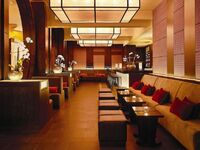 You can find a Nobu in many parts of the globe, including Istanbul. I went to many of them, but as I’ve probably pointed out before, my favorite ones are the ones in Cape Town and Malibu. They have a very satisfactory wine menu that includes famous wines from South Africa. The food, seating arrangement, and atmosphere are exquisite. I really like eating morina fish here. Named Black Cod on the menu, this dish is cooked on a leaf and served with a slightly sweet sauce. Hand rolls with crispy seaweed, warm rice, and cold fish are delicious. You can also dine outdoors. The hotel bar that’s right next to the restaurant turns into a very popular meeting spot at night. I recommend grabbing some appetizers at the hotel bar and moving to Nobu for dinner. If you don’t want to leave the wonderful bar, you can also try convincing Nobu to serve you at the bar.
You can find a Nobu in many parts of the globe, including Istanbul. I went to many of them, but as I’ve probably pointed out before, my favorite ones are the ones in Cape Town and Malibu. They have a very satisfactory wine menu that includes famous wines from South Africa. The food, seating arrangement, and atmosphere are exquisite. I really like eating morina fish here. Named Black Cod on the menu, this dish is cooked on a leaf and served with a slightly sweet sauce. Hand rolls with crispy seaweed, warm rice, and cold fish are delicious. You can also dine outdoors. The hotel bar that’s right next to the restaurant turns into a very popular meeting spot at night. I recommend grabbing some appetizers at the hotel bar and moving to Nobu for dinner. If you don’t want to leave the wonderful bar, you can also try convincing Nobu to serve you at the bar.
FYN
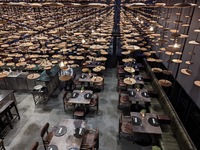 FYN is a new restaurant opened by three partners. One of the partners is a chef, one is a sommelier, and the other is the restaurant manager. The menu mostly consists of French cuisine but they’ve created a fusion with South African dishes. The architecture is impressive with its high ceilings and comfortable sofas. They have different menus for pescatarians, vegetarians, and vegans. These 10-15 course menus change according to day and season. You can also do wine tasting in addition to the menu. However, my advice would be to choose a wine from the wine menu instead of going for the tasting experience because tasting menus offered in such restaurants usually consist of below-average wines. On the flip side, FYN has an extensive wine menu with very expensive wines, mostly from South African wineries.
FYN is a new restaurant opened by three partners. One of the partners is a chef, one is a sommelier, and the other is the restaurant manager. The menu mostly consists of French cuisine but they’ve created a fusion with South African dishes. The architecture is impressive with its high ceilings and comfortable sofas. They have different menus for pescatarians, vegetarians, and vegans. These 10-15 course menus change according to day and season. You can also do wine tasting in addition to the menu. However, my advice would be to choose a wine from the wine menu instead of going for the tasting experience because tasting menus offered in such restaurants usually consist of below-average wines. On the flip side, FYN has an extensive wine menu with very expensive wines, mostly from South African wineries.
CHEFS WAREHOUSE
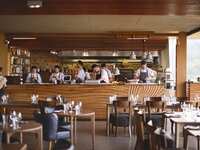 One of the newest restaurants in Cape Town is Chefs Warehouse. There are 5 restaurants under the same name with different concepts across the city. Liam Tomlin, the owner of the Chefs Warehouses, opened his first restaurant in Sydney in 1997 which became very successful. So successful that it wins one of the biggest restaurant awards there. He moved to South Africa in 2003 and opened the first Chefs Warehouse in 2010. In time, he turns the restaurant into the kind of place that serves tapas-style. Meanwhile, he raises his own chefs and brings each one to manage the new places he’s opening. There’s only one rule: although all the chefs are trained in the same way, they’re completely free to do whatever they want with the Chefs Warehouse they’re appointed at. Ingredients are bought by the HQ, so the quality remains across all Chefs Warehouse branches. These 5 restaurants carry the same name, but essentially, they’re all very different from one another. Each chef offers a style to their customers. The maximum capacity for each restaurant is 30 people. I went to one of the most important Chefs Warehouses, Maison, and left very satisfied. Maison is located in the winery region and is a 45-minute drive from the city. It’s a rustic place with wooden tables. The top of the dining area is covered, but the walls are open, overlooking a wide garden. A huge, black wild boar stands in the garden. It’s almost like a mascot. The boar hangs out in the garden, eats, and even joins you at your table. I’ll admit that it’s startling at first, but you get used to it. Here, too, you can select your dish from the menu prepared according to your eating practice. Menus are prepared daily, considering the ingredients. I like this because it’s very attractive to know that each time I visit, I’ll eat something different.
One of the newest restaurants in Cape Town is Chefs Warehouse. There are 5 restaurants under the same name with different concepts across the city. Liam Tomlin, the owner of the Chefs Warehouses, opened his first restaurant in Sydney in 1997 which became very successful. So successful that it wins one of the biggest restaurant awards there. He moved to South Africa in 2003 and opened the first Chefs Warehouse in 2010. In time, he turns the restaurant into the kind of place that serves tapas-style. Meanwhile, he raises his own chefs and brings each one to manage the new places he’s opening. There’s only one rule: although all the chefs are trained in the same way, they’re completely free to do whatever they want with the Chefs Warehouse they’re appointed at. Ingredients are bought by the HQ, so the quality remains across all Chefs Warehouse branches. These 5 restaurants carry the same name, but essentially, they’re all very different from one another. Each chef offers a style to their customers. The maximum capacity for each restaurant is 30 people. I went to one of the most important Chefs Warehouses, Maison, and left very satisfied. Maison is located in the winery region and is a 45-minute drive from the city. It’s a rustic place with wooden tables. The top of the dining area is covered, but the walls are open, overlooking a wide garden. A huge, black wild boar stands in the garden. It’s almost like a mascot. The boar hangs out in the garden, eats, and even joins you at your table. I’ll admit that it’s startling at first, but you get used to it. Here, too, you can select your dish from the menu prepared according to your eating practice. Menus are prepared daily, considering the ingredients. I like this because it’s very attractive to know that each time I visit, I’ll eat something different.
CATHERINAS
I’d like to recommend one more restaurant, especially for golf enthusiasts: Catherina’s at Steenberg. Serving a menu focused on fish, the restaurant is located on a golf course 20 minutes from town. If you like playing golf and care about what you eat, it’s definitely worth a try.
LAST WORD
There are two places to visit touristically in Cape Town. One is Boulder Beach with African penguins, and the other is Cape of Good Hope, the southernmost tip of the African continent. Both are around 45 minutes away from Cape Town. African penguins, which are about 50 cm in height, are a species that live only in the southern waters of Africa. You can see thousands of them in this bay. They go out to the sea, disappear for 3-5 months and then come back. The male and female of these monogamous penguins take turns protecting the egg. I would definitely recommend it as it is a very fun and informative trip. Cape of Good Hope faces the Atlantic on one side and the Indian Ocean on the other. The Atlantic side is cold and wavy. It’s not preferred for swimming but attracts surfers. The Indian Ocean side is warmer, thus more suitable for swimming, but there’s a danger of sharks. People swim here in the summer months when some protective measures are taken. This place is a must-see spot. You can visit both of these places by staying at Cape Town, but you can also stay at a small hotel in Long Beach called Last Word. It only has 6 rooms, accompanied by a beautiful restaurant. This hotel restaurant, which can accommodate a maximum of 15 people, is really nice. The restaurant serves dishes from the local cuisine and mainly consists of fresh seafood bought from the nearby fishing villages. It’s very close to both of the tourist spots I mentioned. Rooms have a terrific view of the ocean. You can walk along the beach that stretches for kilometers, inhale the smell of seaweed and ride a bike. Better yet, watching the sunset and the moonrise is quite enjoyable at Last Word

